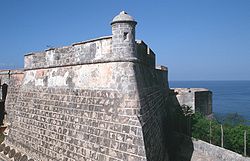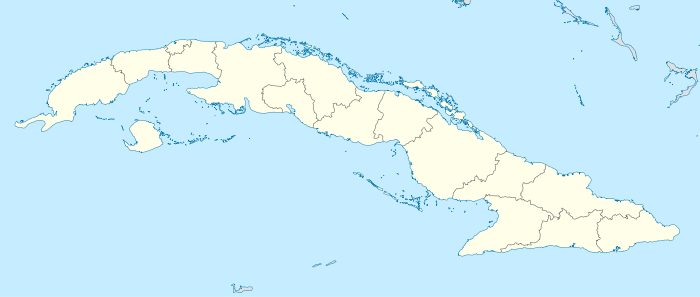- List of World Heritage Sites in Cuba
-
The United Nations Educational, Scientific and Cultural Organization (UNESCO) World Heritage Sites are places of importance to cultural or natural heritage as described in the UNESCO World Heritage Convention, established in 1972.[1] The Caribbean island-nation of Cuba accepted the convention on March 24, 1981, making its historical sites eligible for inclusion on the list; as of 2011, nine sites in Cuba are included.[2]
Cuba had its first site included on the list at the 6th Session of World Heritage Committee, held at UNESCO headquarters in Paris, France, in December 1982. At that session, "Old Havana and its Fortifications", a site including the central, historic portion of the Cuban capital of Havana, as well as Spanish colonial fortifications, was inscribed on the list.[3]
Cuba's inclusions on the list include a variety of sites. Two sites are selected for their natural significance: Alejandro de Humboldt National Park in the eastern provinces of Holguín and Guantánamo,[4] and Desembarco del Granma National Park, named for the yacht which carried the members of the 26th of July Movement who started the Cuban Revolution.[5] City landscapes include Old Havana,[6] Trinidad,[7] and Camagüey,[8] all founded by early Spanish colonists in the 16th century. The sites also include historical agricultural regions, including the coffee plantations of southeastern Cuba,[9] and the tobacco region of Viñales Valley.[10]
Contents
List of sites
The table lists information about each World Heritage Site:
- Name: as listed by the World Heritage Committee
- Region: of the 15 provinces of Cuba1
- Period: time period of significance, typically of construction
- UNESCO data: the site's reference number; the year the site was inscribed on the World Heritage List; the criteria it was listed under: criteria (i) through (vi) are cultural, while (vii) through (x) are natural; sites meeting both criteria are categorized as "mixed sites",[11] the column sorts by year.
- Description: brief description of the site
Name Image Province Period UNESCO data Description Ref(s) Old Havana and its Fortifications La Habana 16th to 19th centuries 204; 1982; iv, v Havana was founded in 1519 by Spanish colonists, growing to become one of the Caribbean's primary ship-building centers by the 17th century. The old city was built in the Baroque and Neoclassical styles. Historical landmarks in Old Havana include La Cabaña, the Cathedral of Havana and the Great Theatre of Havana. [6] Trinidad and the Valley de los Ingenios 
Sancti Spíritus 16th to 19th centuries 460; 1988; iv, v The city of Trinidad was founded in the early 16th century. In 1518, Hernán Cortés began his expedition to conquer Mexico from the port at Trinidad. The city prospered throughout the colonial period in large part due to the success of the local sugar industry. The adjacent Valley de los Ingenios was the origin of the Cuban sugar industry, which emerged in the 18th century. It is home to numerous cane sugar mills, as well as cattle ranches and tobacco plantations. [7][12] San Pedro de la Roca Castle, Santiago de Cuba 
Santiago de Cuba 17th century 841; 1997; iv; v The large fort was built to defend the important port of Santiago de Cuba. The design of the fortification was based on Italian and Renaissance architecture. The complex of magazines, bastions, and batteries is one of the most complete and well-preserved Spanish-American defense fortifications. [13] Desembarco del Granma National Park — Granma N/A 889; 1999; vii, viii The national park is named for the yacht which carried Fidel Castro, Raúl Castro, Che Guevara and the other 79 members of the 26th of July Movement to Cuba to overthrow Fulgencio Batista. The park features a unique karst topography with features such as terraces, cliffs, and waterfalls. [5][14] Viñales Valley 
Pinar del Río Province 19th century 840; 1999; iv The village of Viñales was founded in 1875 after the expansion of tobacco cultivation in the surrounding valley. The Valley features a karst topography, vernacular architecture, and traditional cultivation methods. The Valley was also the site of various military engagements in the Cuban War of Independence and Cuban Revolution. [10][15] Archaeological Landscape of the First Coffee Plantations in the South-East of Cuba — Santiago de Cuba and Guantánamo 19th and 20th centuries 1008; 2000; iii, iv During the 19th and early 20th centuries, eastern Cuba was primarily involved with coffea cultivation. The remnants of the plantations display the techniques used in the difficult terrain, as well as the economic and social significance of the plantation system in Cuba and the Caribbean. [9] Alejandro de Humboldt National Park 
Holguín and Guantánamo N/A 839; 2001; ix, x The rivers that originate in the high elevations are among the largest of the Insular Caribbean. The park exhibits a wide array of geology types. It contains many biological species, including 16 of Cuba's 28 endemic plant species, as well as animal species such as the endangered Cuban Solenodon. [4][16] Urban Historic Centre of Cienfuegos Cienfuegos 19th century 1202; 2005; ii, v Cienfuegos was founded in 1819 as a Spanish colony, though its first inhabitants were French immigrants. It became a trade center in the sugar cane, tobacco, and coffee trade because of its location on the Bay of Cienfuegos. Because of its establishment in the later colonial period, the architecture has more modern influences: including modern ideas of urban planning. [17] Historic Centre of Camagüey 
Camagüey 16th century 1270; 2008; iv, v Camagüey is among the first seven villages founded by the Spanish in Cuba, first settled in 1528. The irregular organization of the city is distinct from the typical, orderly construction of most other Spanish settlements. This maze-like style was influenced by medieval European ideas and traditional construction methods of early immigrant masons and construction workers. [8] Tentative list
In addition to sites inscribed on the World Heritage list, member states can maintain a list of tentative sites that they may consider for nomination. Nominations for the World Heritage list are only accepted if the site was previously listed on the tentative list.[18] As of 2011, Cuba listed three sites on its tentative list:[19]
- Ciénaga de Zapata National Park: The park is listed as a Biosphere Reserve and has a variety of landscapes and species, including mangrove forests and stretches of coral reef.[20]
- National Schools of Art, Cubanacán: The National Schools of Art was established in 1962 to train artists in plastic arts, music, ballet, drama, modern and folkloric dancing. The architecture is a Cuban contemporary style with the architects using brick in place of cement which was scarce at the time.[21]
- Reef System in the Cuban Caribbean: The site includes different sections of coral reef across the southern coast, particularly centered around the Canarreos and Jardines de la Reina archipelagos. The site stretches from the Guanahacabibes peninsula at the westernmost point of Cuba to the Jardines de la Reina in the southeast. In total, the system is 800 kilometers (500 mi) long and includes nine different protected sites.[22]
Location of sites
Notes
- 1. ^ Isla de la Juventud is defined as a special municipality rather than a province. On January 1, 2011, La Habana Province was divided into Artemisa and Mayabeque, and "Ciudad de La Habana" is now referred to as La Habana province.[23]
References
- ^ "The World Heritage Convention". UNESCO. http://whc.unesco.org/en/convention/. Retrieved September 21, 2010.
- ^ a b "Cuba". UNESCO. http://whc.unesco.org/en/statesparties/cu/. Retrieved October 12, 2010.
- ^ "Report of the Rapporteur". UNESCO. January 17, 1983. http://whc.unesco.org/archive/repcom82.htm. Retrieved October 12, 2010.
- ^ a b "Alejandro de Humboldt National Park". UNESCO. http://whc.unesco.org/en/list/839. Retrieved October 22, 2010.
- ^ a b "Desembarco del Granma National Park". UNESCO. http://whc.unesco.org/en/list/889. Retrieved October 22, 2010.
- ^ a b "Old Havana and its Fortifications". UNESCO. http://whc.unesco.org/en/list/204. Retrieved October 7, 2010.
- ^ a b "Trinidad and the Valley de los Ingenios". UNESCO. http://whc.unesco.org/en/list/460. Retrieved October 14, 2010.
- ^ a b "Historic Centre of Camagüey". UNESCO. http://whc.unesco.org/en/list/1270. Retrieved October 22, 2010.
- ^ a b "Archaeological Landscape of the First Coffee Plantations in the South-East of Cuba". UNESCO. http://whc.unesco.org/en/list/1008. Retrieved October 22, 2010.
- ^ a b "Viñales Valley". UNESCO. http://whc.unesco.org/en/list/840. Retrieved October 22, 2010.
- ^ "The Criteria of Selection". UNESCO. http://whc.unesco.org/en/criteria/. Retrieved November 10, 2010.
- ^ "Trinidad, Cuba". Organization of World Heritage Cities. http://www.ovpm.org/en/cuba/trinidad. Retrieved October 14, 2010.
- ^ "San Pedro de la Roca Castle, Santiago de Cuba". UNESCO. http://whc.unesco.org/en/list/841. Retrieved October 22, 2010.
- ^ "In Depth: Dear Granma". Bayamo Travel Guide. Frommers. http://www.frommers.com/destinations/bayamo/3199010012.html. Retrieved November 12, 2010.
- ^ "Viñales (Cuba)" (pdf). UNESCO. http://whc.unesco.org/archive/advisory_body_evaluation/840.pdf. Retrieved October 22, 2010.
- ^ "Solenodon cubanus". International Union for Conservation of Nature. http://www.iucnredlist.org/apps/redlist/details/20320/0. Retrieved November 12, 2010.
- ^ "Urban Historic Centre of Cienfuegos". UNESCO. http://whc.unesco.org/en/list/1202. Retrieved October 22, 2010.
- ^ "Tentative Lists". UNESCO. http://whc.unesco.org/en/tentativelists/. Retrieved October 7, 2010.
- ^ "Tentative List – Cuba". UNESCO. http://whc.unesco.org/en/tentativelists/state=cu. Retrieved October 7, 2010.
- ^ "Ciénaga de Zapata National Park". UNESCO. http://whc.unesco.org/en/tentativelists/1801/. Retrieved October 30, 2010.
- ^ "National Schools of Art, Cubanacán". UNESCO. http://whc.unesco.org/en/tentativelists/1798/. Retrieved October 30, 2010.
- ^ "Reef System in the Cuban Caribbean". UNESCO. http://whc.unesco.org/en/tentativelists/1802/. Retrieved October 30, 2010.
- ^ Núñez Betancourt, Alberto. "La racionalidad como premisa" (in Spanish). Granma. http://www.granma.cubaweb.cu/2010/06/08/nacional/artic04.html. Retrieved November 9, 2010.
Lists of World Heritage Sites Africa · Americas · Asia (Northern and Central · Western · Eastern · Southern · South-Eastern) · Europe (Northern · Western · Eastern · Southern) · Oceania
World Heritage in Danger · Former sites Categories:
Categories:- World Heritage Sites in Cuba
- Lists of Heritage Sites
Wikimedia Foundation. 2010.



